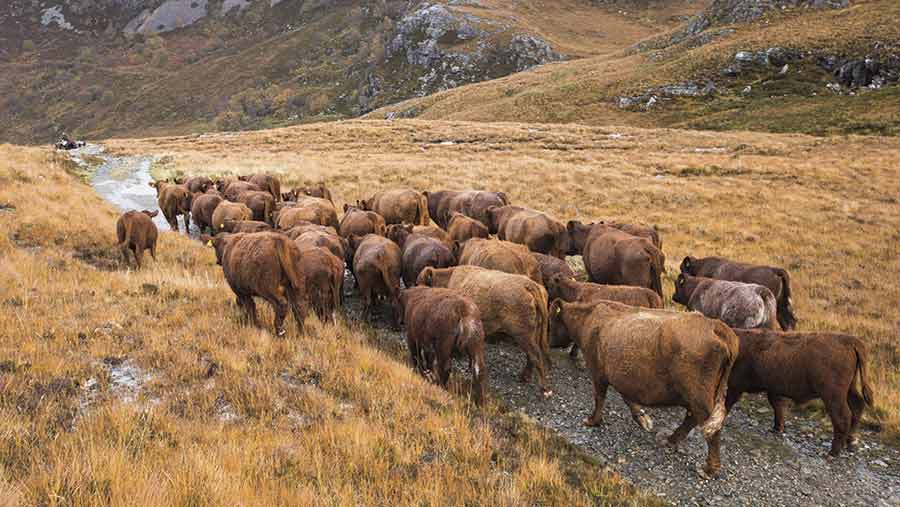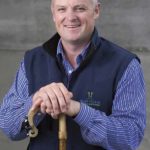Why the Luing breed is a hit with beef farmers
In the past 10 years the number of registered Luing breeders has more than doubled from 159 to 323.
This is due to the breed’s ability to consistently raise a quality calf on even the harshest ground, and without a need to resort to concentrate feeding.

© Global Warming Images/Rex/Shutterstock
The Sim-Luing offshoot has also proved a hit on many commercial systems, combining the hardiness and mothering instinct of the Luing with the milkiness and frame of the Simmental.
See also: Wagyu beef adds value to dairy calf enterprise
The breed, formally established in the 1960s, is mostly concentrated in Scotland, but more and more breeders throughout the UK are now beginning to take to the Luing and the Sim-Luing, which can be used on any terminal sire.
We look at two farmers who have opted to run Luings because of the advantages the breed offers.
John Scott, Fearn Farm, Ross-shire

John Scott © Jim Varney
John Scott, who runs Fearn Farm just north of Inverness, has recently started to develop a Luing herd and is now looking to establish them as a key element in his wider cattle enterprise.
The family has a long association with the Shorthorn, but after taking on another farming unit around 20 miles north up the coast in Sutherland around four years ago, Mr Scott opted for the Luing as the land there was of poorer quality compared to Fearn.
“There were two or three herds of Luing up that part of the coast already and they seemed to do quite well,” says Mr Scott. “It’s quite an exposed spot, too.
Cheap to keep
“We were looking for a cow that would forage year-round, outdoors and be cheap to keep – basically one that could get on with it herself and produce a calf every 12 months with little intervention. That’s why we chose the Luings and they’ve done just as we hoped.”
Farm facts
- 410ha
- 121ha rented
- Another 1,052ha in Sutherland
- 4,200 ewes
- 120 cows (including 60 pedigree Shorthorn) and 40 Luings
- 142ha of malting spring barley
- 32ha of winter barley for feeding
- 32ha let for potatoes
- Three full-time staff and one part-time
Mr Scott is now in his third year of calving Luings and definitely likes what he sees.
The original purchases were bulling heifers bought from Dingwall mart, where they hold a special pedigree Luing sale every May.
For the last three years, as well as sourcing more heifers from Dingwall, nine-year-old in-calf cows have been purchased from the Cadzow family on the island of Luing, from where, as the name suggests, the breed originates.
Feed
The Luings only get silage and straw through the winter and maybe a bucket but they don’t receive hard feeding, says Mr Scott.
“They are going to play a big part in our plans going forward and potentially the Sim-Luings, too.”
“This year we finished the bulls entirely as bull beef but I think we will be going back to steers and finish them at 18-20 months old on grazing down here at Fearn,” says Mr Scott.
Bull beef is currently sold deadweight to ABP meat suppliers and some of the heifers not retained for breeding are sold in Dingwall.
Expansion plans
The Luing herd at Fearn currently numbers 40 but there are plans to increase that to up to 70.
“Next year we are going to look at other options for steers,” says Mr Scott.
“We’re not quite fully into a system for the male calves yet. We’ve been focused on building the numbers at the moment so we have kept everything pure.
“As our business grows and we take on more farms, and if the Luings are suited to that ground, then the logical thing for us to do is to have more of the same. We’re all looking for a low-cost suckler cow and the Luing certainly does that.
There may be the option yet of putting a proportion of the herd to the Simmental to give us another option, another outlet and another product to sell. But we’ll see.”
Facts about the Luing breed
The Luing was only established in 1965 after being in development by the Cadzow brothers on the island of Luing for more than 10 years.
- The Cadzow family still has a significant operation on the island.
- The breed is essentially a cross between the Highland and Shorthorn and devised in order to produce a cow that could withstand the wet winters and harsh conditions of the west coast of Scotland and still return a profit.
- Significant improvements have been made to the breed over the years thanks to strict rules surrounding criteria at the pedigree sales. Bulls must be at least 52in in height at the shoulder at 18 months of age and have a scrotal circumference of no less than 38cm.
- The breed society also operates a dam classification scheme.
Davie Nicol, Balcaskie Farm, East Fife
Davie Nicol, of Balcaskie Farm in East Fife, has been breeding Sim-Luings since taking over as farm manager of the 1,000ha in 2007, but the breed was well-established on the farm well before then.
The herd is currently divided into 100 pure Luings and 170 Sim-Luings.
“The Sim-Luing is a hell of a good breed; very docile with great mothering instincts,” says Mr Nicol. “Where we are we have a grassy hill and they are just great grass converters. They are milky cows and make a hell of a job of their calves.”
Around 15 bulling heifers are bought in every year, usually from Stirling (last year’s average price was £1,750).
Breeding
“We try and buy the better end cause that’s really the base of our herd, so we don’t mind spending a bit of money on these 15 every year because the entire genetics of our herd come from them.”
Farm facts
- 1,000ha
- 400ha arable
- 600ha undergoing organic conversion
- Four full-time staff and Mr Nicol
The pure Luings are put to the Simmental, with all the resulting female progeny retained on-farm.
A mixture of Limousin and Simmental bulls are then put on the resultant Sim-Luings, with a Shorthorn over the heifers to ease with calving.
Similar to the pure Luings, the Sim-Luings at Balcaskie are also wintered on silage and straw alone, although there is enough room for all the cows to be wintered inside.
Calving percentage for the spring calving herd runs at about 93% with weaning taking place in November. Normally, all progeny is finished on-farm for the fat trade.
“This year we did sell about 20-30 stores because the price of fat cattle was absolutely hopeless – we decided to take the money and run. But, usually, we don’t sell any stores; we fatten everything ourselves.”
Finished cattle are sold at 18-20 months to Scotbeef, though some this year was sold to McIntosh Donald due to problems in getting them into the supply chain. The steers average 380kg deadweight; 320 for the heifers and 80-90% of carcasses grading out at R4L.
